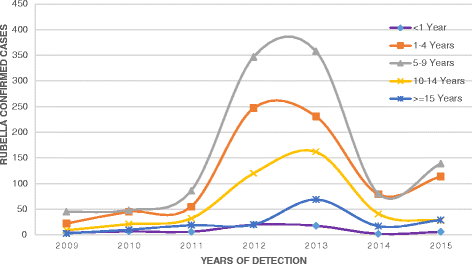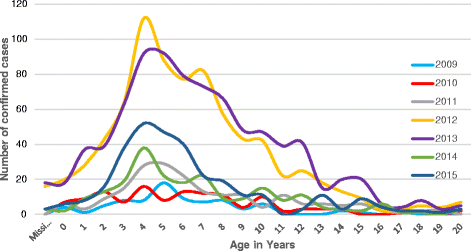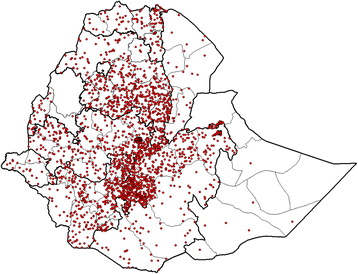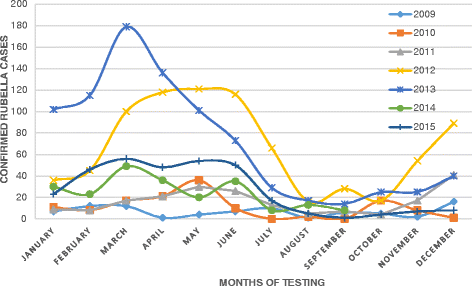Epidemiology of rubella virus cases in the pre-vaccination era of Ethiopia, 2009-2015
- PMID: 27863513
- PMCID: PMC5116171
- DOI: 10.1186/s12889-016-3841-z
Epidemiology of rubella virus cases in the pre-vaccination era of Ethiopia, 2009-2015
Abstract
Background: Rubella is a common mild rash illness caused by rubella virus. The majority of infections occur in children and young adults. The infection is the cause of a serious birth defect known as Congenital Rubella Syndrome (CRS) when a woman acquires infection early in pregnancy. Ethiopia has not yet established rubella virus surveillance and has not yet introduced rubella vaccine into the routine immunization program. We characterize the epidemiology of laboratory confirmed rubella virus cases collected through measles surveillance from 2009 to 2015 to better understand the burden of the disease in the country.
Methods: A descriptive analysis was made to characterize rubella cases reported through the national measles case based surveillance system. The measles case definition was used to capture potential rubella cases. A suspected measles case was a person with generalized rash and fever with cough, or coryza or conjunctivitis. Those cases whose sera were negative for measles IgM antibodies were tested for rubella IgM antibody. A confirmed rubella case was a person who tested positive for rubella IgM. Only laboratory confirmed rubella cases were analyzed in this article.
Results: Between 2009 and 2015, a total of 28,284 serum/plasma samples were collected and tested for measles IgM antibody and 11,151 (39.4%) were found positive. A total of 17,066 measles IgM negative or indeterminate samples were tested for rubella virus IgM and 2615 (15.3%) were found positive during the same period. Of 2615 confirmed rubella cases, 52.2% were females. The age of confirmed cases ranged from one month to 42 years with a mean age of 7.3 years. Three-fourth of all confirmed rubella cases were aged less than 10 years. The number of laboratory confirmed rubella cases linearly increased from 83 in 2009 to 856 in 2013 but dropped to 222 and 319 in 2014 and 2015 respectively. Higher number of cases occurred in the hot dry season (January through June) and in the central and western part of Ethiopia with 127 lab-confirmed outbreaks in the study period.
Conclusions: Based on our analysis, rubella was found to be endemic throughout Ethiopia. Children below the age of 10 years were the most affected. The burden of rubella cases varied from year to year but had a seasonal peak in March. To better understand the magnitude of rubella prior to vaccine introduction, establishing rubella surveillance system, conducting sero-prevalence studies among child bearing age females and establishing CRS sentinel surveillance among young infants are critical.
Keywords: 2009–2015; Ethiopia; Pre-vaccine era; Rubella.
Figures




Similar articles
-
Descriptive epidemiology of rubella disease and associated virus strains in Uganda.J Med Virol. 2020 Mar;92(3):279-287. doi: 10.1002/jmv.25604. Epub 2019 Oct 9. J Med Virol. 2020. PMID: 31598987 Free PMC article.
-
Rubella transmission and the risk of congenital rubella syndrome in Liberia: a need to introduce rubella-containing vaccine in the routine immunization program.BMC Infect Dis. 2019 Sep 18;19(1):813. doi: 10.1186/s12879-019-4464-7. BMC Infect Dis. 2019. PMID: 31533658 Free PMC article.
-
Epidemiology of acute rubella infection in Zambia during the pre-vaccination period (2005-2016) as a baseline for monitoring rubella epidemiology in the post-rubella vaccine introduction era.BMC Infect Dis. 2020 Feb 3;20(1):101. doi: 10.1186/s12879-020-4806-5. BMC Infect Dis. 2020. PMID: 32013873 Free PMC article.
-
Congenital rubella syndrome: a matter of concern.Rev Panam Salud Publica. 2015 Mar;37(3):179-86. Rev Panam Salud Publica. 2015. PMID: 25988255 Review.
-
Rubella and congenital rubella (German measles).J Long Term Eff Med Implants. 2005;15(3):319-28. doi: 10.1615/jlongtermeffmedimplants.v15.i3.80. J Long Term Eff Med Implants. 2005. PMID: 16022642 Review.
Cited by
-
Risk Factors for Rubella Transmission in Kuyu District, Ethiopia, 2018: A Case-Control Study.Interdiscip Perspect Infect Dis. 2019 Sep 16;2019:4719636. doi: 10.1155/2019/4719636. eCollection 2019. Interdiscip Perspect Infect Dis. 2019. PMID: 31636663 Free PMC article.
-
Descriptive epidemiology of rubella disease and associated virus strains in Uganda.J Med Virol. 2020 Mar;92(3):279-287. doi: 10.1002/jmv.25604. Epub 2019 Oct 9. J Med Virol. 2020. PMID: 31598987 Free PMC article.
-
Epidemiology of Rubella Virus in a Fragile and Conflict-affected Setting - A Retrospective Analysis of 11 Years Case-based Data in South Sudan.Open Forum Infect Dis. 2025 Apr 9;12(5):ofaf221. doi: 10.1093/ofid/ofaf221. eCollection 2025 May. Open Forum Infect Dis. 2025. PMID: 40406370 Free PMC article.
-
Perinatal outcome of pregnant mothers with active rubella infection in a tertiary hospital in Nigeria.Ghana Med J. 2025 Mar;59(1):15-21. doi: 10.4314/gmj.v59i1.3. Ghana Med J. 2025. PMID: 40620392 Free PMC article.
-
Rubella outbreak in the school children, Addis Ababa, Ethiopia: February-April 2018.BMC Infect Dis. 2019 Mar 18;19(1):267. doi: 10.1186/s12879-019-3873-y. BMC Infect Dis. 2019. PMID: 30885148 Free PMC article.
References
-
- CDC . Epidemiology and prevention of vaccine-preventable diseases. Chapter 20, rubella. Pink book. 13 2015.
-
- Rubella vaccines: WHO position Paper. 2011;86(29):301–16. http://www.who.int/wer/2011/wer8629/en/. - PubMed
-
- Heymann DL, editor. Control of communicable diseases manual. 18. Washington: American Public Health Association; 2004.
-
- Measles & Rubella: Eliminating Measles, Rubella & Congenital Rubella Syndrome (CRS) Worldwide, CDC Global Health. http://www.cdc.gov/globalhealth/measles/pdf/measles-factsheet2015.pdf.
-
- Best JM, Banatvala JE. Rubella. In: Zuckerman AJ, Banatvala JE, Pattison JR, Griffiths PD, Schoub BD, editors. Principles and practice of clinical virology. 5. West Suusex: Wiley; 2004. pp. 427–457.
MeSH terms
Substances
Grants and funding
LinkOut - more resources
Full Text Sources
Other Literature Sources
Medical
Miscellaneous

